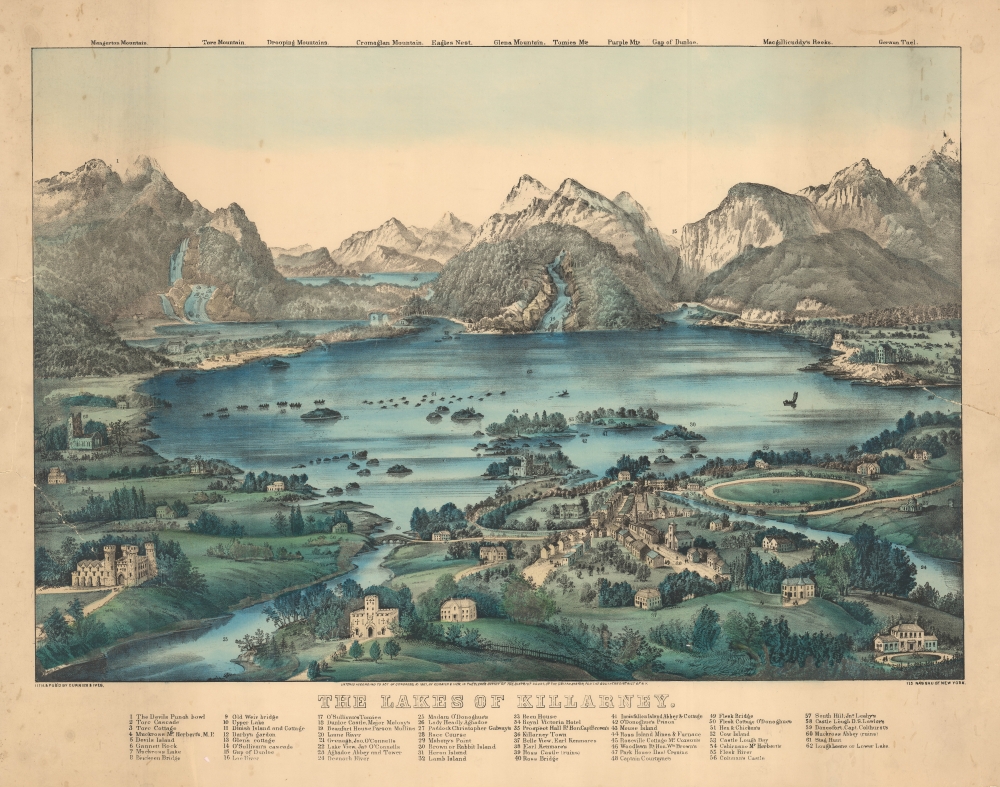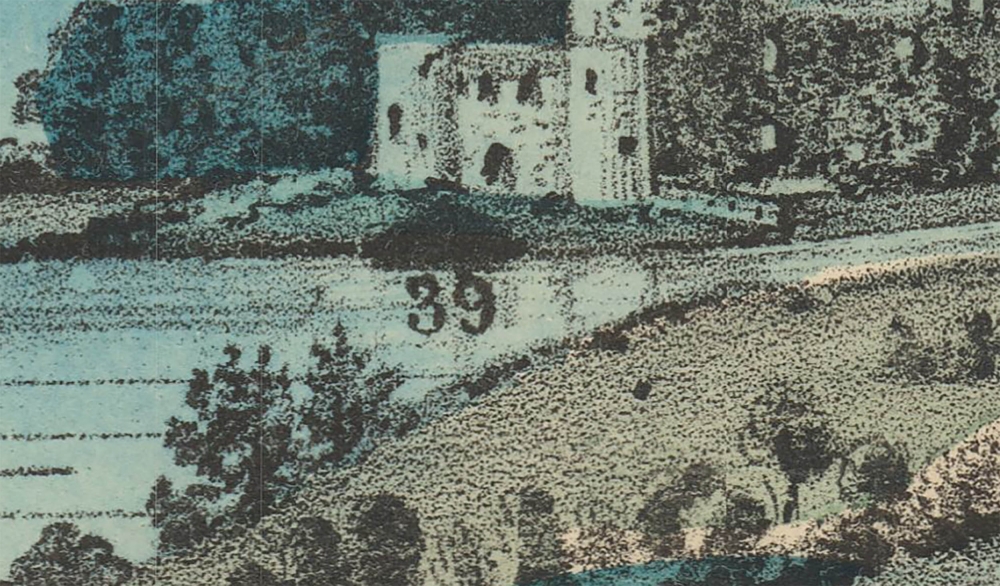1867 Currier and Ives View of the Lakes of Killarney, Ireland
LakesofKillarney-currierives-1867
Title
1867 (dated) 21 x 26.5 in (53.34 x 67.31 cm)
Description
A Closer Look
The view is a highly stylized image of the lakes, likely based upon an earlier painting or engraving. Some of the proportions are exaggerated or reduced to present the vast area of Killarney in a cohesive singular image. The key below identifies some 62 locations, including Devils Punch Bowl, the Toto Cascades, the Upper Lake, Muckrose Lake, Lough Leane or Lower lake, Old Weir Bridge, Brickeen Bridge, Gannett Rook, Cow Island, Hens and Chickens, Muckross Abbey ruins, Coltman's Caste, Flask River, Flask Bridge, Rose Castle ruins, Ross Island, Innisfallen Island Abbey and Cottage, Killarney Town, Belle View Earl Kenmares, Lady Headleys Aghadoe, Deenach River, The Race Course, Aghadoe Abbey and Tower, Laune River, Loe River, and O'Sullivans Cascade, another others.Lakes of Killarney
The Lakes of Killarney are a renowned scenic attraction located in Killarney National Park, County Kerry, Ireland. Comprising three main lakes – Lough Leane, Muckross Lake, and Upper Lake – they are set against the backdrop of the stunning MacGillycuddy's Reeks mountain range. Rich in biodiversity, the lakes are home to myriad fish species, and their shores are dotted with ancient woodlands, historic sites, and diverse flora and fauna. The interplay of mountain, woodland, and water has made the Lakes of Killarney a symbol of Ireland's natural beauty.Authenticating
Currier and Ives prints achieved an immense following and, with the firm's closure, reproductions began appearing. This has led to considerable apprehension among collectors who rightly fear they may be buying a reproduction. In most cases, the original lithographic plates were destroyed, so the first step identifying an authentic piece is identifying the near-irreplicable pattern of a stone lithograph under high magnification. We are including an image of such for edification.Publication History and Census
This view was published in 1867 by Currier and Ives. It was issued in both large and small format editions, this is the large format. The view was widely reproduced, but originals in the large format edition are increasingly rare.CartographerS
Nathaniel Currier (March 27, 1813 - November 20, 1888) was an American lithographer best known as part of 'Currier and Ives'. Born in Roxbury, Massachusetts, Currier attended public schools until fifteen, when he apprenticed with the Boston lithographic firm of William and John Pendleton. The Pendletons were the first successful lithographers in the United States and were responsible for educating the next generation of lithographic printers. In 1833, Currier left the Pendleton's shop to work with M.E.D. Brown in Philadelphia. A year later, Currier moved to New York City, where he planned to start a business with John Pendleton. When Pendleton backed out, Currier found a new partner, founding 'Currier and Stodart', but the concern survived for just a year. Currier opened his own lithographic studio in 1835 as an eponymous sole-proprietorship. He initially printed the standard materials, including letterheads, sheet music, and handbills. Later in 1835, Currier began issuing current event imagery. Some of his news printers were issued in the New York Sun. By 1840, Currier had moved away from 'job printing' and further toward fine-print publishing. His Awful Conflagration of the Steam Boat 'Lexington', was published in the Sun that year, as well as being separately issued. James Ives (March 5, 1824 - January 3, 1895) began working under Currier in 1850 as a bookkeeper. Ives contributed greatly to the growth of the business, particularly as a manager, marketer, and businessman. Ives became a full partner in 1857, and the firm was renamed 'Currier and Ives'. Currier and Ives produced over 7,500 images and is best remembered for its popular art prints, particularly Christmas scenes and landscapes. They also produced banners, illustrations of current events, views, and historical scenes. Currier retired in 1880 and turned the business over to his son Edward. Currier married Eliza West Farnsworth in 1840, with whom he had one child Edward West Currier. Eliza died in 1843. Currier remarried to Lura Ormsbee in 1847. Other than being a lithographer, Currier also served as a volunteer New York City fireman during the 1850s, and he liked fast horses. More by this mapmaker...
James Merritt Ives (March 5, 1824 - January 3, 1895) was an American businessman, bookkeeper, and lithographer who oversaw the business side of the famed lithographic firm Currier and Ives. Born in New York City, Ives was a self-trained artist who began working at the age of twelve. He married Caroline Clark (1827 - 1896) on June 24, 1846, who was the sister-in-law of Nathaniel Currier's brother, Charles Currier. In 1852, Nathaniel Currier (March 27, 1813 - November 20, 1888) hired Ives as the bookkeeper for his firm N. Currier, Lithographer, on Charles's recommendation. Ives' talent for art and his knowledge of the artistic world soon became apparent to Currier, who valued his insights as well as the business acumen. Currier offered Ives a full partnership in 1857. They renamed the firm 'Currier and Ives' with Ives as the general manager. Ives began to play a role in selecting artists and prints to publish, and was responsible for pursuing publication of scenes of middle-class America that made the firm famous. After Ives died in 1895, his sons continued to work with Currier's son to manage the firm until it was liquidated in 1907. Learn More...




